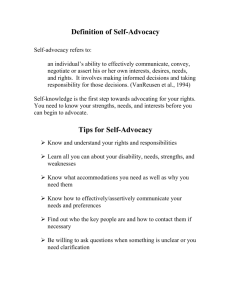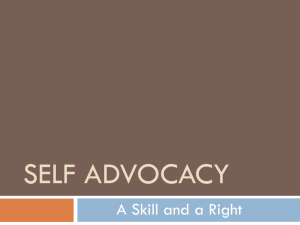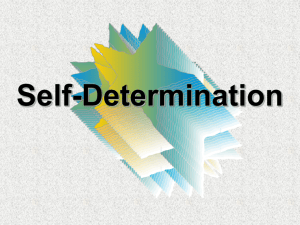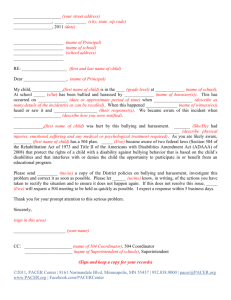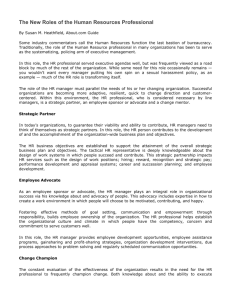Be Your Own Best Advocate
advertisement
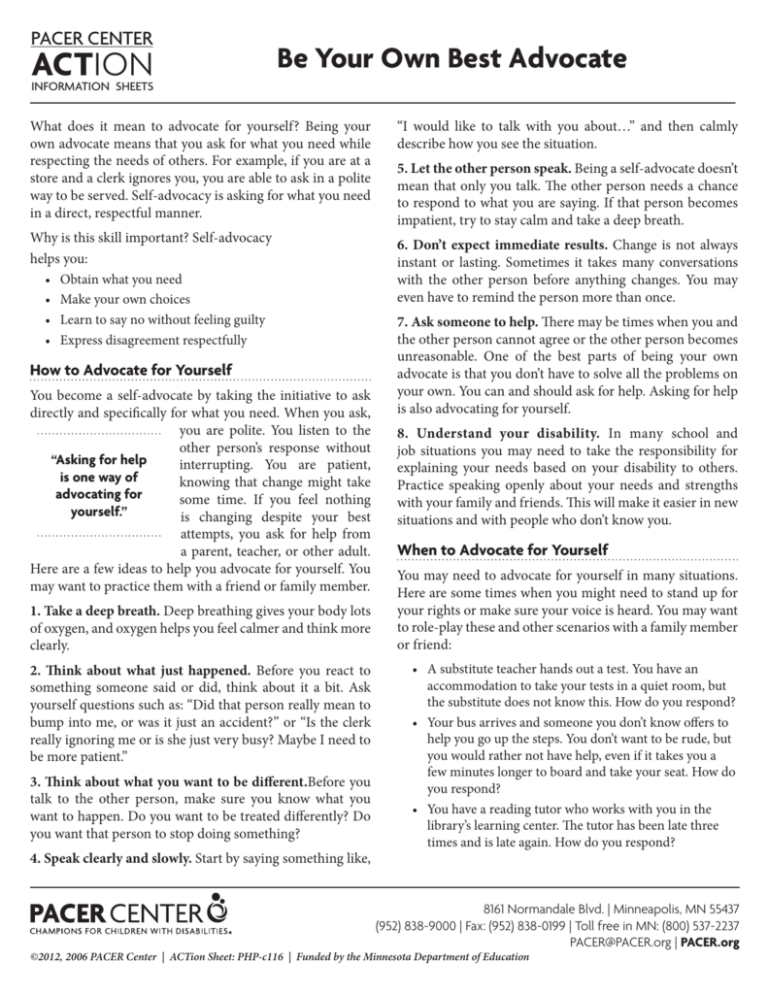
PACER CENTER ACTION Be Your Own Best Advocate INFORMATION SHEETS What does it mean to advocate for yourself? Being your own advocate means that you ask for what you need while respecting the needs of others. For example, if you are at a store and a clerk ignores you, you are able to ask in a polite way to be served. Self-advocacy is asking for what you need in a direct, respectful manner. “I would like to talk with you about…” and then calmly describe how you see the situation. Why is this skill important? Self-advocacy helps you: • Obtain what you need • Make your own choices • Learn to say no without feeling guilty • Express disagreement respectfully 6. Don’t expect immediate results. Change is not always instant or lasting. Sometimes it takes many conversations with the other person before anything changes. You may even have to remind the person more than once. How to Advocate for Yourself You become a self-advocate by taking the initiative to ask directly and specifically for what you need. When you ask, you are polite. You listen to the other person’s response without “Asking for help interrupting. You are patient, is one way of knowing that change might take advocating for some time. If you feel nothing yourself.” is changing despite your best attempts, you ask for help from a parent, teacher, or other adult. Here are a few ideas to help you advocate for yourself. You may want to practice them with a friend or family member. 1. Take a deep breath. Deep breathing gives your body lots of oxygen, and oxygen helps you feel calmer and think more clearly. 2. Think about what just happened. Before you react to something someone said or did, think about it a bit. Ask yourself questions such as: “Did that person really mean to bump into me, or was it just an accident?” or “Is the clerk really ignoring me or is she just very busy? Maybe I need to be more patient.” 3. Think about what you want to be different.Before you talk to the other person, make sure you know what you want to happen. Do you want to be treated differently? Do you want that person to stop doing something? 4. Speak clearly and slowly. Start by saying something like, 5. Let the other person speak. Being a self-advocate doesn’t mean that only you talk. The other person needs a chance to respond to what you are saying. If that person becomes impatient, try to stay calm and take a deep breath. 7. Ask someone to help. There may be times when you and the other person cannot agree or the other person becomes unreasonable. One of the best parts of being your own advocate is that you don’t have to solve all the problems on your own. You can and should ask for help. Asking for help is also advocating for yourself. 8. Understand your disability. In many school and job situations you may need to take the responsibility for explaining your needs based on your disability to others. Practice speaking openly about your needs and strengths with your family and friends. This will make it easier in new situations and with people who don’t know you. When to Advocate for Yourself You may need to advocate for yourself in many situations. Here are some times when you might need to stand up for your rights or make sure your voice is heard. You may want to role-play these and other scenarios with a family member or friend: • A substitute teacher hands out a test. You have an accommodation to take your tests in a quiet room, but the substitute does not know this. How do you respond? • Your bus arrives and someone you don’t know offers to help you go up the steps. You don’t want to be rude, but you would rather not have help, even if it takes you a few minutes longer to board and take your seat. How do you respond? • You have a reading tutor who works with you in the library’s learning center. The tutor has been late three times and is late again. How do you respond? 8161 Normandale Blvd. | Minneapolis, MN 55437 (952) 838-9000 | Fax: (952) 838-0199 | Toll free in MN: (800) 537-2237 PACER@PACER.org | PACER.org ©2012, 2006 PACER Center | ACTion Sheet: PHP-c116 | Funded by the Minnesota Department of Education Self-Determination Synthesis Project www.uncc.edu/home.asp This project includes information about self-determination resources, such as research references, curricula, Web links, and other materials. From the University of North Carolina, Charlotte, it includes links to many lesson plans. How to Learn More about Self-advocacy No one is born knowing how to be their own self-advocate. It is a learned skill. You can find out more about it by watching someone who is a good advocate (a parent, aunt, uncle, or neighbor, for example). What is the tone of their voice? How do they stand? Do they make eye contact? What else do you notice? Promoting Self-Determination in Students with Developmental Disabilities by M.L.Wehmeyer,Ph.D., (2007). Guilford Press, New York, NY. This book offers practical methods for teaching selfdetermination, including choice making, problem solving, decision making, goal setting, self-advocacy, and self-regulated learning. It also provides best-practice recommendations. Special features include reproducible worksheets and forms. Available at www.amazon.com You also can check out these helpful resources for teens and families. For Teens: www.fvkasa.org This site is from Kids as Self Advocates (KASA), a national, grassroots network of youth with disabilities and needs speaking out about living with disabilities, health care, transition issues, school, work, and more. Self-Determination for Middle and High School Students National Center on Secondary Education and Transition (NCSET) This NCSET handout is a helpful resource for those addressing self-advocacy and self-determination issues. NCSET coordinates national resources, offers technical assistance, and disseminates information related to secondary education and transition for youth with disabilities. Available at http://ncset.org/topics/sdmhs/default.asp?topic=30. www.mcil-mn.org This site is from the Metropolitan Center for Independent Living in Minnesota, which helps people with disabilities live independently, pursue meaningful goals, and enjoy the same opportunities and choices as all persons. Programs are often available for transition age self-advocacy training and peer mentors. For Families: Developing Positive Assertiveness: Practical Techniques for Personal Success by Sam R. Lloyd, (2001). Crisp Publications, Los Altos, CA This book is for anyone who wants to take charge of their life. It includes a helpful collection of practice situations. Available at www.amazon.com 2
